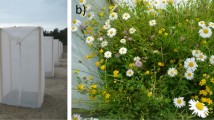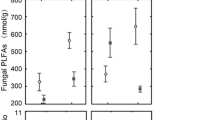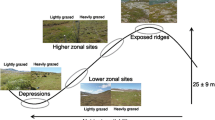Abstract
Aims
Recently, much attention has been paid to the plant-mediated effects of aboveground herbivory on soil ecosystems. However, studies about the herbivore-induced effects of invasive plants on soil ecosystem are still lacking. In this study, we aimed to examine the soil biota and nutrient availability to an invasive plant under aboveground herbivory stress, and compare the soil responses with a native plant.
Methods
We subjected an invasive plant (Spartina alterniflora) and a native plant (Phragmites australis) to herbivory by caterpillars of native moth Laelia coenosa, and measured soil microbes, nematodes, inorganic nitrogen (N), plant biomass and N content.
Results
Soil microbial biomass, nematode abundance, ammonium N concentrations and N mineralization rates were significantly stimulated by herbivory of the invasive S. alterniflora. Besides, the stimulation of bacteria: fungi ratio, abundance of bacterivorous nematodes, and ammonium N availability were significantly higher for S. alterniflora than for P. australis.
Conclusions
In general, aboveground insect herbivory of the invasive S. alterniflora enhanced the abundance of soil biota, and the soil N availability. The greater soil responses associated with S. alterniflora suggest stronger positive soil feedback than those with the native P. australis, which might facilitate the invasive plant to successfully invade its new range under biotic stress.






Similar content being viewed by others
References
Ayres E, Heath J, Possell M, Black HIJ, Kerstiens G, Bardgett RD (2004) Tree physiological responses to above-ground herbivory directly modify below-ground processes of soil carbon and nitrogen cycling. Ecol Lett 7:469–479
Bardgett RD, Wardle DA (2003) Herbivore-mediated linkages between aboveground and belowground communities. Ecology 84:2258–2268
Bardgett RD, Hobbs PJ, Frostegard A (1996) Changes in soil fungal: bacterial biomass ratios following reductions in the intensity of management of an upland grassland. Biol Fertil Soils 22:261–264
Bardgett RD, Wardle DA, Yeates GW (1998) Linking above-ground and below-ground interactions: how plant responses to foliar herbivory influence soil organisms. Soil Biol Biochem 14:1867–1878
Bezemer TM, Harvey JA, Cronin JT (2014) Response of native insect communities to invasive plants. Annu Rev Entomol 59:119–141
Bonkowski M, Griffiths B, Scrimgeour C (2000) Substrate heterogeneity and microfauna in soil organic 'hotspots' as determinants of nitrogen capture and growth of ryegrass. Appl Soil Ecol 14:37–53
Bossio DA, Scow KM (1998) Impacts of carbon and flooding on soil microbial communities: phospholipid fatty acid profiles and substrate utilization patterns. Microb Ecol 35:265–278
Brzezinski MA (1987) Colorimetric determination of nanomolar concentrations of ammonium in seawater using solvent-extraction. Mar Chem 20:277–288
Campos-Herrera R, Ali JG, Diaz BM, Duncan LW (2013) Analyzing spatial patterns linked to the ecology of herbivores and their natural enemies in the soil. Front Plant Sci 4:378
Chapman SK, Hart SC, Cobb NS, Whitham TG, Koch GW (2003) Insect herbivory increases litter quality and decomposition: an extension of the acceleration hypothesis. Ecology 84:2867–2876
Chen Z, Li B, Zhong Y, Chen J (2004) Local competitive effects of introduced Spartina alterniflora on Scirpus mariqueter at Dongtan of Chongming Island, the Yangtze River estuary and their potential ecological consequences. Hydrobiologia 528:99–106
Chen H, Li B, Hu J, Chen J, Wu J (2007) Effects of Spartina alterniflora invasion on benthic nematode communities in the Yangtze estuary. Mar Ecol Prog Ser 336:99–110
de Jonge VN, Bouwman LA (1977) A simple density separation technique for quantitative isolation of meiobenthos using the colloidal silica Ludox-TM. Mar Biol 42:143–148
Doorduin LJ, Vrieling K (2011) A review of the phytochemical support for the shifting defence hypothesis. Phytochem Rev 10:99–106
Ferris H (2010) Contribution of nematodes to the structure and function of the soil food web. J Nematol 42:63–67
Frank DA, Kuns MM, Guido DR (2002) Consumer control of grassland plant production. Ecology 83:602–606
Gal C, Frenzel W, Moller JR (2004) Re-examination of the cadmium reduction method and optimisation of conditions for the determination of nitrate by flow injection analysis. Microchim Acta 146:155–164
Hamilton EW, Frank DA (2001) Can plants stimulate soil microbes and their own nutrient supply? Evidence from a grazing tolerant grass. Ecology 82:2397–2402
Hamilton EW, Frank DA, Hinchey PM, Murray TR (2008) Defoliation induces root exudation and triggers positive rhizospheric feedbacks in a temperate grassland. Soil Biol Biochem 40:2865–2873
Ilmarinen K, Mikola J, Nissinen K, Vestberg M (2009) Role of soil organisms in the maintenance of species-rich seminatural grasslands through mowing. Restor Ecol 17:78–88
Inderjit, van der Putten WH (2010) Impacts of soil microbial communities on exotic plant invasions. Trends Ecol Evol 25:512–519
Johnson SN, Clark KE, Hartley SE, Jones TH, McKenzie SW, Koricheva J (2012) Aboveground-belowground herbivore interactions: a meta-analysis. Ecology 93:2208–2215
Joshi J, Vrieling K (2005) The enemy release and EICA hypothesis revisited: incorporating the fundamental difference between specialist and generalist herbivores. Ecol Lett 8:704–714
Ju RT, Chen YY, Gao L, Li B (2016) The extended phenology of Spartina invasion alters a native herbivorous insect's abundance and diet in a Chinese salt marsh. Biol Invasions 18:2229–2236
Kaukonen M, Ruotsalainen AL, Wali PR, Mannisto MK, Setala H, Saravesi K, Huusko K, Markkola A (2013) Moth herbivory enhances resource turnover in subarctic mountain birch forests? Ecology 94:267–272
Keane RM, Crawley MJ (2002) Exotic plant invasions and the enemy release hypothesis. Trends Ecol Evol 17:164–170
Kodama T, Ichikawa T, Hidaka K, Furuya K (2015) A highly sensitive and large concentration range colorimetric continuous flow analysis for ammonium concentration. J Oceanogr 71:65–75
Lenoir L, Persson T, Bengtsson J, Wallander H, Wirén A (2007) Bottom–up or top–down control in forest soil microcosms? Effects of soil fauna on fungal biomass and C/N mineralisation. Biol Fertil Soils 43:281–294
Li B, Liao CZ, Zhang XD, Chen HL, Wang Q, Chen ZY, Gan XJ, Wu JH, Zhao B, Ma ZJ, Cheng X, Jiang LF, Chen JK (2009) Spartina alterniflora Invasions in the Yangtze River estuary, China: an overview of current status and ecosystem effects. Ecol Eng 35:511–520
Li H, Zhang X, Zheng R, Li X, Elmer WH, Wolfe LM, Li B (2014) Indirect effects of non-native Spartina alterniflora and its fungal pathogen (Fusarium palustre) on native saltmarsh plants in China. J Ecol 102:1112–1119
Liang X, Zheng H, He CQ, Xu QY, Zhan YW, Lei YR, Du W, Yang JN (2012) Allelopathic effcts of invasive Spartina alterniflora root exudates in soil on the offspring (seeds) of Scirpus mariqueter. Allelopath J 29:251–262
Ma D, Ju R, Li B (2015) Preference of Laelia coenosa for native and introduced populations of invasive Spartina alterniflora. Biodivers Sci 23:101–108
Medina-Roldán E, Paz-Ferreiro J, Bardgett RD (2012) Grazing-induced effects on soil properties modify plant competitive interactions in semi-natural mountain grasslands. Oecologia 170:159–169
Mikola J, Yeates GW, Barker GM, Wardle DA, Bonner KI (2001) Effects of defoliation intensity on soil food-web properties in an experimental grassland community. Oikos 92:333–343
Orrock JL, Dutra HP, Marquis RJ, Barber N (2015) Apparent competition and native consumers exacerbate the strong competitive effect of an exotic plant species. Ecology 96:1052–1061
Parepa M, Schaffner U, Bossdorf O (2013) Help from under ground: soil biota facilitate knotweed invasion. Ecosphere 4:t31
Pejchar L, Mooney HA (2009) Invasive species, ecosystem services and human well-being. Trends Ecol Evol 24:497–504
Peng RH, Fang CM, Li B, Chen JK (2011) Spartina alterniflora Invasion increases soil inorganic nitrogen pools through interactions with tidal subsidies in the Yangtze estuary, China. Oecologia 165:797–807
Pineda A, Soler R, Pozo MJ, Rasmann S, Turlings TCJ (2015) Editorial: above-belowground interactions involving plants, microbes and insects. Front Plant Sci 6:318
Reinhart KO, Callaway RM (2006) Soil biota and invasive plants. New Phytol 170:445–457
Rogers WE, Siemann E (2002) Effects of simulated herbivory and resource availability on native and invasive exotic tree seedlings. Basic Appl Ecol 3:297–307
Rogers WE, Siemann E (2004) Invasive ecotypes tolerate herbivory more effectively than native ecotypes of the Chinese tallow tree Sapium sebiferum. J Appl Ecol 41:561–570
Russell FL, Louda SM, Rand TA, Kachman SD (2007) Variation in herbivore-mediated indirect effects of an invasive plant on a native plant. Ecology 88:413–423
Sankaran M, Augustine DJ (2004) Large herbivores suppress decomposer abundance in a semiarid grazing ecosystem. Ecology 85:1052–1061
Siemann E, Rogers WE (2003) Reduced resistance of invasive varieties of the alien tree Sapium sebiferum to a generalist herbivore. Oecologia 135:451–457
Stanford G, Smith SJ (1972) Nitrogen mineralization potential of soil. Soil Sci Soc Am Proc 36:465–472
Stark S, Wardle DA, Ohtonen R, Helle T, Yeates GW (2000) The effect of reindeer grazing on decomposition, mineralization and soil biota in a dry oligotrophic scots pine forest. Oikos 90:301–310
Stark S, Strommer R, Tuomi J (2002) Reindeer grazing and soil microbial processes in two suboceanic and two subcontinental tundra heaths. Oikos 97:69–78
Strayer DL, Eviner VT, Jeschke JM, Pace ML (2006) Understanding the long-term effects of species invasions. Trends Ecol Evol 21:645–651
Thelen GC, Vivanco JM, Newingham B, Good W, Bais HP, Landres P, Caesar A, Callaway RM (2005) Insect herbivory stimulates allelopathic exudation by an invasive plant and the suppression of natives. Ecol Lett 8:209–217
van Dam NM, Heil M (2011) Multitrophic interactions below and above ground: en route to the next level. J Ecol 99:77–88
Vance ED, Brookes PC, Jenkinson DS (1987) An extraction method for measuring soil microbial biomass C. Soil Biol Biochem 19:703–707
Vilà M, Espinar JL, Hejda M, Hulme PE, Jarošík V, Maron JL, Pergl J, Schaffner U, Sun Y, Pyšek P (2011) Ecological impacts of invasive alien plants: a meta-analysis of their effects on species, communities and ecosystems. Ecol Lett 14:702–708
Wardle DA, Yeates GW (1993) The dual importance of competition and predation as regulatory forces in terrestrial ecosystems-evidence from decomposer food webs. Oecologia 93:303–306
Wardle DA, Verhoef HA, Clarholm M (1998) Trophic relationships in the soil microfood-web: predicting the responses to a changing global environment. Glob Chang Biol 4:713–727
Wardle DA, Barker GM, Yeates GW, Bonner KI, Ghani A (2001) Introduced browsing mammals in New Zealand natural forests: aboveground and belowground consequences. Ecol Monogr 71:587–614
Wardle DA, Yeates GW, Williamson WM, Bonner KI, Barker GM (2004) Linking aboveground and belowground communities: the indirect influence of aphid species identity and diversity on a three trophic level soil food web. Oikos 107:283–294
Warning SA, Bremner JM (1964) Ammonium production in soil under waterlogged conditons as an index of nitrogen avaliabliity. Nature 201:951–952
Weidenhamer JD, Callaway RM (2010) Direct and indirect effects of invasive plants on soil chemistry and ecosystem function. J Chem Ecol 36:59–69
Yeates GW, Williams PA (2001) Influence of three invasive weeds and site factors on soil microfauna in New Zealand. Pedobiologia 45:367–383
Yeates GW, Bongers T, Degoede R, Freckman DW, Georgieva SS (1993) Feeding-habits in soil nematode families and genera- an outline for soil ecologists. J Nematol 25:315–331
Zhang B, Zhou X, Zhou L, Ju R (2015) A global synthesis of below-ground carbon responses to biotic disturbance: a meta-analysis. Glob Ecol Biogeogr 24:126–138
Ziter C, MacDougall AS (2013) Nutrients and defoliation increase soil carbon inputs in grassland. Ecology 94:106–116
Acknowledgements
We would like to thank Professor Anthony John Davy for his constructive comments on an early version of this manuscript. We also thank Ding Ma for assistance with preparing insect materials, Sikai Wang and Zaichao Yang for help with collecting plant and soil materials. This research was financially supported by National Basic Research Program of China (Grant No. 2013CB430404) and the National Natural Science Foundation of China (31670544).
Author information
Authors and Affiliations
Corresponding author
Additional information
Responsible Editor: Hans Lambers.
Rights and permissions
About this article
Cite this article
Zhou, J., Ju, R., Li, B. et al. Responses of soil biota and nitrogen availability to an invasive plant under aboveground herbivory. Plant Soil 415, 479–491 (2017). https://doi.org/10.1007/s11104-017-3179-z
Received:
Accepted:
Published:
Issue Date:
DOI: https://doi.org/10.1007/s11104-017-3179-z




